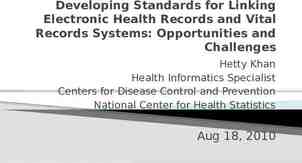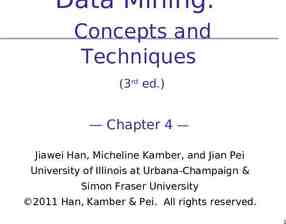Geog 458: Map Sources and Error January 18, 2006 Georeferencing
12 Slides159.00 KB

Geog 458: Map Sources and Error January 18, 2006 Georeferencing

Outlines Placenames Postal addresses Metric georeferencing 1D: Linear referencing systems 3D: Unprojected coordinate system 2D: Projected coordinate system Geodetic model Map projection: how it works Grid coordinate systems: UTM, SPC Metadata content standard: spatial reference

Placenames Simplest form of georeferencing Limited use in GIS due to imprecise location; meaning of placenames Where do you live? I live in university district can vary between people, and with context can be uniquely identified with proper geographic hierarchy can change over time To be used in GIS or other applications, it is necessary to systematically identify precise location of names of geographic features GNIS (Geographic Names Information System) In the website, find out what it is, how it works, and purposes

Postal addresses Widely used to identify the location of dwellings Based on several assumptions Local areas are identified with proper geographic hierarchy Path is unique within local areas Dwellings are numbered consecutively along the path How does address-matching work? Look at TIGER/Line road data Linear interpolation based on topologic data Any limitation?

Linear referencing Identify location on a network by measuring distance from a defined point of reference along a defined path in the network 1-dimensional: stored in a tabular form Widely used in highway agency (DOT): vary by State, reference point is split along administrative boundary Look at NHPN data

Geodetic model To determine the location precisely, it is necessary to define the shape of earth Earth is not quite spherical, but rather ellipsoid Ellipsoid (a.k.a. spheroid): geodetic model of the earth Flattening ratio defines how the model differs from sphere Different ellipsoid has different flattening ratio Ellipsoid can be either earth-centered (global) or not (local), arising from the need to approximate the shape of the earth suited to varying coverage areas NAD29 is local datum WGS84 is global datum

Unprojected coordinate system 3 dimensional Geographic unit of measurement Decimal degrees degree minute /60 second / 3600 Other names Latitude: angle from the equator Longitude: offset from prime meridian Geographic system of coordinates Plate Carree Since it’s unprojected, it gives a heavily distorted image of the earth (e.g. Antarctica)

Projected coordinate system 2-dimensional; involves map projection (transformation of 3D to 2D); a.k.a. planar coordinate system Projection family (the shape of developable surface) Projection properties (which geometric property is constant?) Cylindrical, conic, planar Equal-area, conformal, equidistance, azimuthal Tangency: Tangent, secant Aspect: Normal, transverse, oblique Standard line or standard parallel Where earth intersects developable surface Line of zero distortion

Grid coordinate systems UTM Universal Transverse Mercator Projection family? Projection property? Tangency? Aspect? 1 zone is ? degree SPC State by state Use three different map projections depending on the shape of zones in State: what are the three projections? Difference between SPC27 and SPC83?

Metadata Content Standard: Section 4: Spatial Reference

Reading metadata content standard

Exercise Georeferencing your house Local Placenames Postal address Linear referencing systems Geographic Planar UTM SPC83






